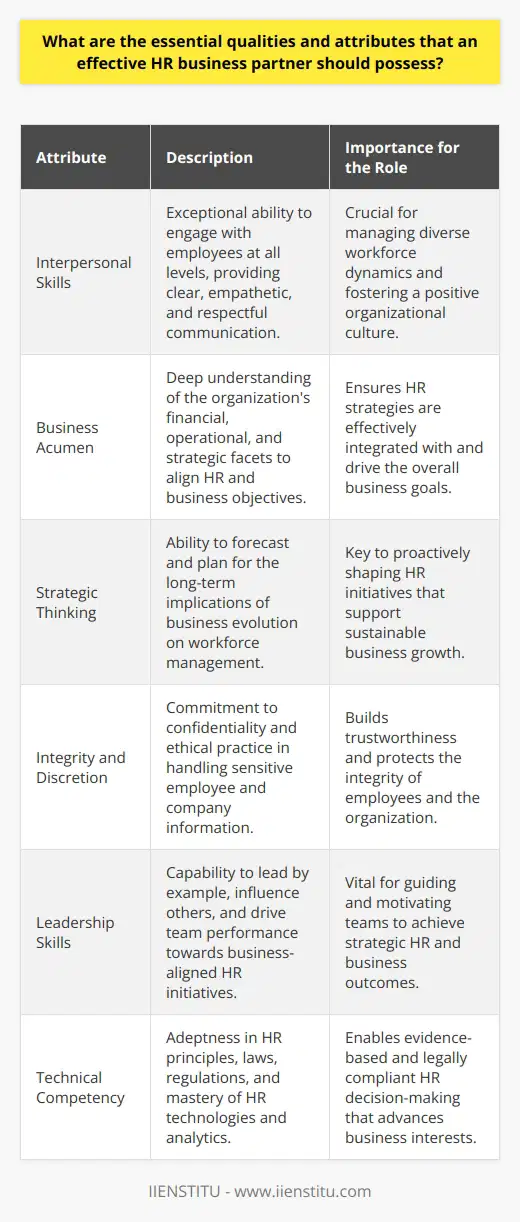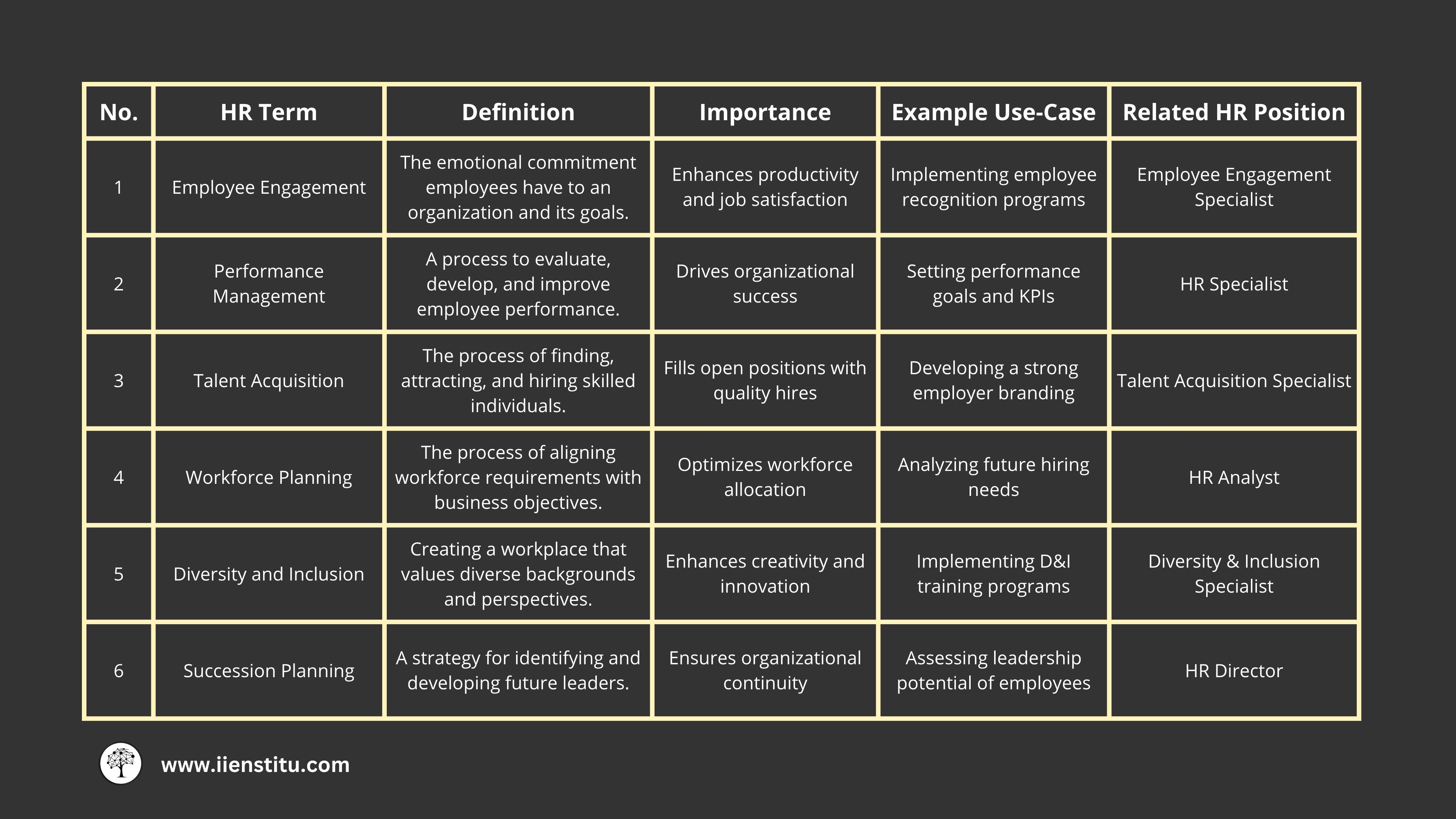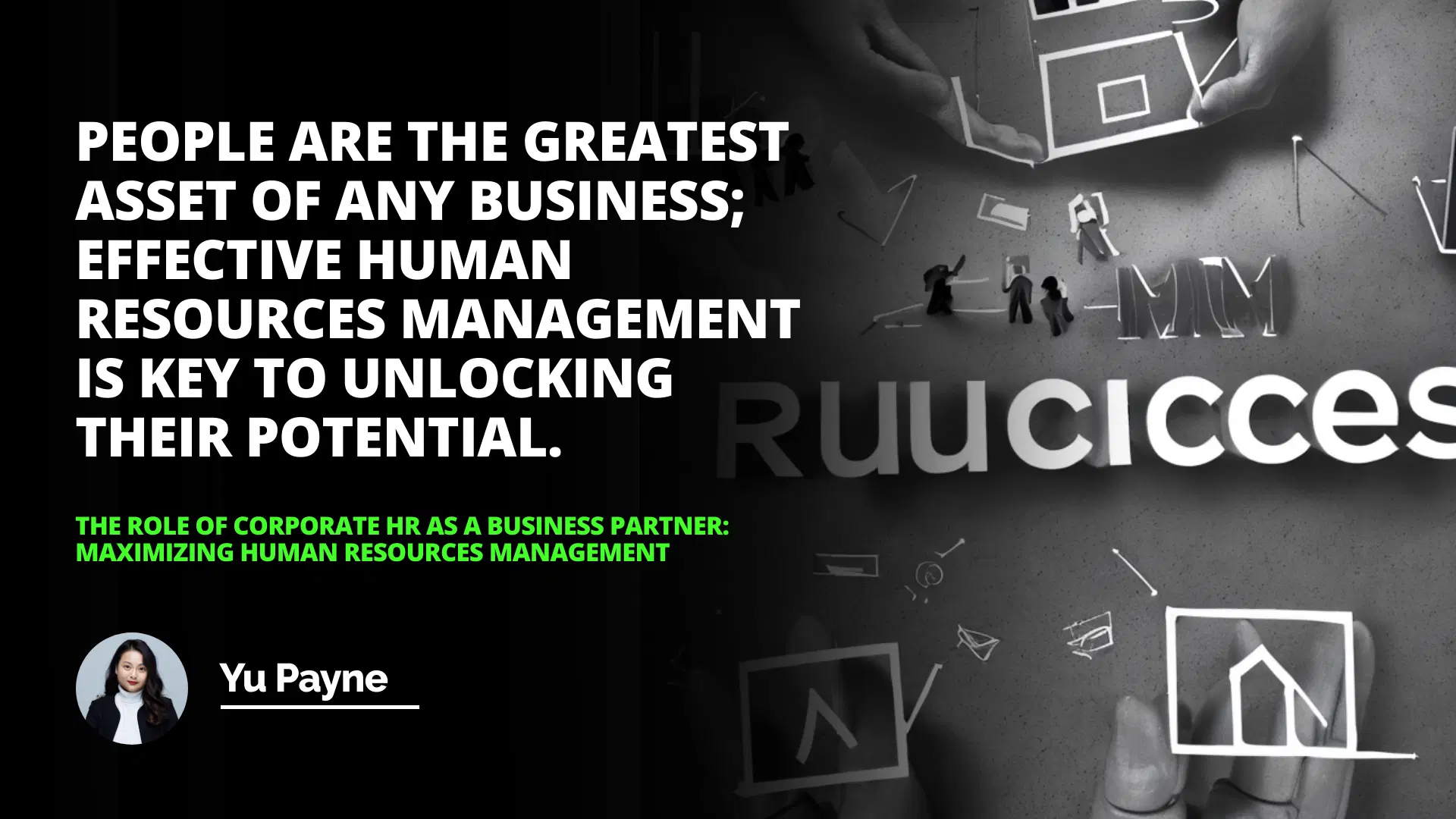
When I first stepped into the world of corporate business, I vividly remember feeling overwhelmed by the sheer complexity of organizational dynamics. Human Resources was a department I hadn't given much thought to, but soon realized it was the heartbeat of the company. Over time, I came to appreciate how integral Corporate HR is, not just in hiring and firing, but in shaping the very fabric of an organization.
The Evolving Role of Corporate HR
In today's fast-paced business environment, Corporate HR has transformed from a back-office function to a strategic partner. Gone are the days when HR was solely about managing personnel files and conducting annual reviews. Now, it's about aligning human resource solutions with the company's long-term goals.
Introduction
The Role of Corporate HR
Human Resources Management
Benefits of Corporate HR as a Business Partner
Conclusion
Think about it: for any business aiming to implement a new project management strategy, understanding the critical path method isn't enough. You need the right people in the right places. That's where HR steps in, ensuring that talent acquisition and development are in sync with project timelines and objectives.
From Administrative to Strategic
The shift from administrative tasks to strategic planning means HR professionals are now deeply involved in:
1- Strategic HR Management: Crafting policies that support the company's direction.
2- Talent Management: Identifying and nurturing potential leaders.
3- Culture Building: Fostering an environment that reflects the organization's values.
4- Change Management: Guiding teams through transitions smoothly.
5- Data Analysis: Utilizing human resource information systems to make informed decisions.
This evolution underscores how human resources services are now pivotal in driving business success.
Human Resources Management: More Than Just Hiring
When my friend Sarah landed her first role in HR, she confessed she thought it would be all about interviews and paperwork. However, she soon discovered that Human Resources Management (HRM) is a multifaceted discipline encompassing:
Employee Engagement: Creating initiatives that keep staff motivated.
Training and Development: Offering programs that enhance skills.
Performance Management: Setting benchmarks and providing feedback.
Compliance: Ensuring all practices meet legal standards.
Benefits Administration: Managing compensation, benefits, and rewards.
It's about strategic human resource management, where the focus is on long-term employee development and retention. After all, high turnover can be detrimental to any organization, both financially and culturally.
The Impact on Employees
A well-executed HRM strategy leads to:
Improved job satisfaction.
Higher productivity levels.
Better team cohesion.
Reduced absenteeism.
Enhanced company reputation.
On the flip side, neglecting HRM can result in a disengaged workforce, which is a hurdle no business wants to face.
Corporate HR as a Business Partner
One of the most significant shifts in modern businesses is viewing HR as a true partner in achieving organizational objectives. This partnership involves collaboration between HR professionals and other departments to drive growth and innovation.
Benefits of This Partnership
1- Unified Goals: Ensuring everyone is working towards the same objectives.
2- Resource Optimization: Making the best use of human resources resources.
3- Enhanced Communication: Breaking down silos between departments.
4- Strategic Planning: Incorporating HR insights into business plans.
5- Employee Advocacy: HR representing staff concerns at the executive level.
When HR and other departments work hand-in-hand, it creates a synergy that propels the company forward. For instance, in tech companies, HR collaborates with IT to understand the specific skills needed, leading to targeted recruitment and training.
Real-world Example
At a previous company I worked for, we faced a major restructuring. Instead of HR simply enforcing top-down decisions, they acted as mediators, gathering feedback from employees and conveying concerns to management. This approach not only eased tensions but also resulted in more practical solutions that benefited everyone.
The Importance of Human Resource Systems
People are the greatest asset of any business; effective Human Resources Management is key to unlocking their potential.
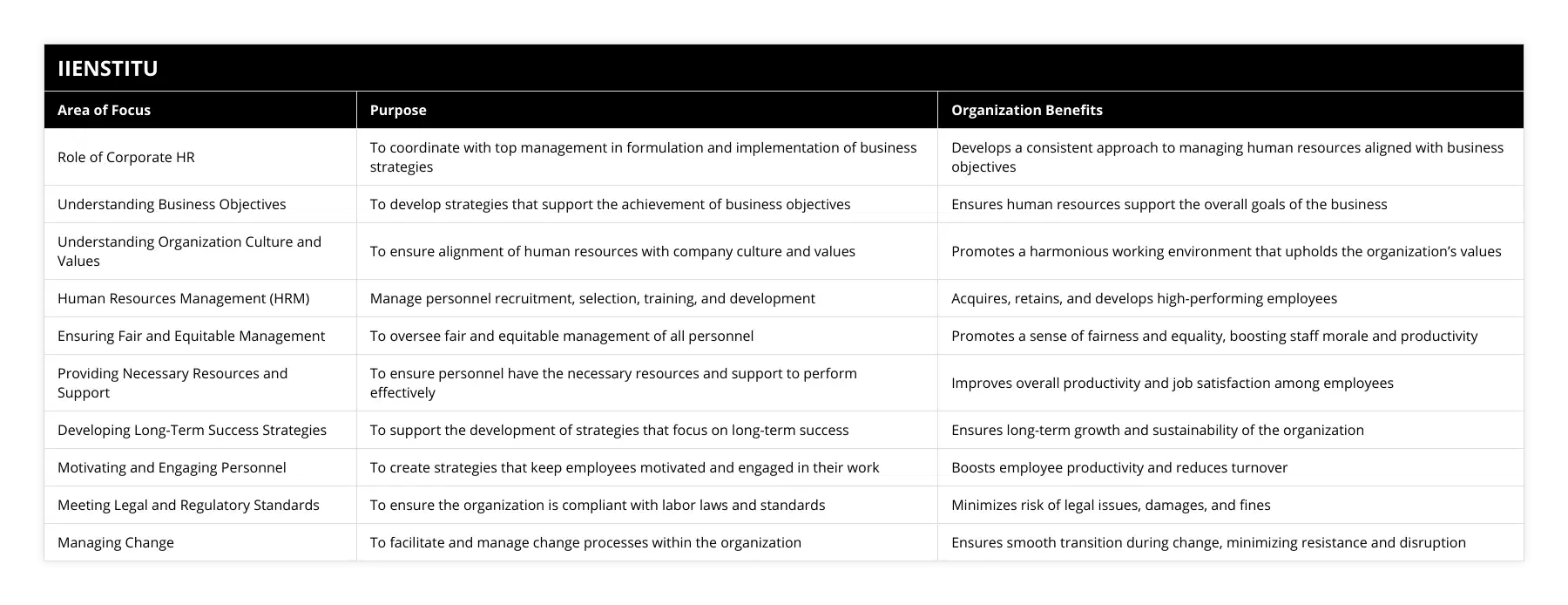
In the digital age, leveraging technology is crucial. Human resource systems (HRS) have become indispensable tools for managing employee data, streamlining processes, and providing analytics that inform strategic decisions.
Advantages of HRS
Efficiency: Automating routine tasks saves time.
Data Accuracy: Reduces errors in record-keeping.
Accessibility: Information is readily available when needed.
Compliance: Helps in adhering to regulations.
Decision Making: Provides insights through data analysis.
Implementing a robust HRS is an investment that pays off by enhancing the overall effectiveness of HR functions.
HR for HR: Supporting the Supporters
It's interesting to consider that while HR is busy supporting the entire organization, they also need resources and development opportunities. HR for HR focuses on equipping HR professionals with the tools and knowledge they need to perform their roles effectively.
Areas of Focus
Professional Development: Ongoing training in the latest HR practices.
Wellness Programs: Addressing burnout and stress management.
Technology Training: Keeping up with new HR software and tools.
Networking Opportunities: Connecting with other HR professionals for shared learning.
By investing in HR staff, organizations ensure that those who are pivotal in managing people are themselves well-supported.
Strategic HR Management in Practice
Strategic HR Management involves aligning HR policies and practices with the strategic objectives of the organization. This means that HR is not just aware of the company's direction but is actively shaping it.
Key Components
1- Workforce Planning: Anticipating future staffing needs.
2- Succession Planning: Preparing for future leadership vacancies.
3- Performance Metrics: Establishing KPIs related to HR outcomes.
4- Cultural Alignment: Ensuring company culture supports strategy.
5- Risk Management: Identifying and mitigating people-related risks.
By adopting a strategic approach, HR can significantly impact the company's ability to achieve its goals.
The Human Touch in Human Resources
At its core, HR is about people. It's easy to get lost in policies, procedures, and systems, but the human element should never be overlooked. Building genuine relationships and understanding individual needs can make a world of difference.
Personal Connections Matter
I'll never forget when, during a challenging time at work, an HR manager took the time to check in with me personally. That simple gesture made me feel valued and more connected to the company. It's these small acts that underscore the importance of empathy and compassion in HR roles.
Underlining the Human Aspect
Active Listening: Truly hearing and understanding employee concerns.
Open Communication: Encouraging transparency at all levels.
Recognition: Acknowledging achievements and contributions.
Support Systems: Providing resources for personal and professional challenges.
Remember, human resources human resources is all about people caring for people.
Conclusion
In wrapping up, it's clear that human resources play an indispensable role in shaping successful organizations. From strategic planning to nurturing individual talent, HR is at the forefront of driving company culture and performance.
Businesses that invest in their HR departments are not just managing employees; they're fostering an environment where everyone can thrive. Whether it's through implementing advanced human resource systems, offering comprehensive human resources services, or aligning HR strategies with business objectives, the impact is profound.
As we move forward in an ever-changing business landscape, the importance of HR as a strategic partner cannot be overstated. They're not just a department; they're the backbone of organizational success. After all, people are the greatest asset of any business, and effective Human Resources Management is key to unlocking their potential.
References
Ulrich, D. (1997). Human Resource Champions: The Next Agenda for Adding Value and Delivering Results. Harvard Business School Press.
Armstrong, M. (2014). Armstrong's Handbook of Human Resource Management Practice. Kogan Page Publishers.
Becker, B. E., & Huselid, M. A. (2006). "Strategic Human Resources Management: Where Do We Go From Here?" Journal of Management, 32(6), 898–925.
Torrington, D., Hall, L., & Taylor, S. (2008). Human Resource Management. Pearson Education Limited.
Lepak, D., & Gowan, M. (2010). Human Resource Management: Managing Employees for Competitive Advantage. Pearson.
Frequently Asked Questions
What are the key responsibilities of Corporate HR as a Business Partner?
The role of Human Resources (HR) within an organization has evolved over the years. While traditionally, HR was seen as a back-office administrative function, today, it is seen as an integral part of the business and as a business partner in its own right. As such, Corporate HR has several critical responsibilities to fulfill to ensure that the organization is successful.
One of Corporate HR’s key responsibilities is ensuring that the organization has a clear strategy and set of goals aligned with the business. HR must be able to anticipate the needs of the business and create plans and processes to ensure that these needs are met. This includes formulating effective recruitment, training, and development strategies to ensure that the organization has the right people in the right roles to achieve its goals.
Another key responsibility of Corporate HR is ensuring that the organization’s culture aligns with the desired business objectives. This involves understanding the organization’s values, how they are expressed in the workplace and how they are reflected in the organization’s policies and practices. It also involves creating a positive working environment that encourages collaboration and innovation.
In addition, Corporate HR must ensure that the organization complies with relevant laws and regulations. This includes understanding and implementing workplace safety regulations, managing employee and labor relations, and ensuring that the organization complies with anti-discrimination and equal opportunity laws.
Finally, Corporate HR plays a key role in managing organizational change. This involves understanding the impact of changes on the organization and its employees, developing and implementing strategies to ensure successful changes, and providing support and guidance to employees during the transition.
In summary, the key responsibilities of Corporate HR as a business partner are: to ensure the organization has an effective strategy and set of goals; to create and maintain a positive workplace culture; to ensure the organization is compliant with relevant laws and regulations; and to manage change within the organization.
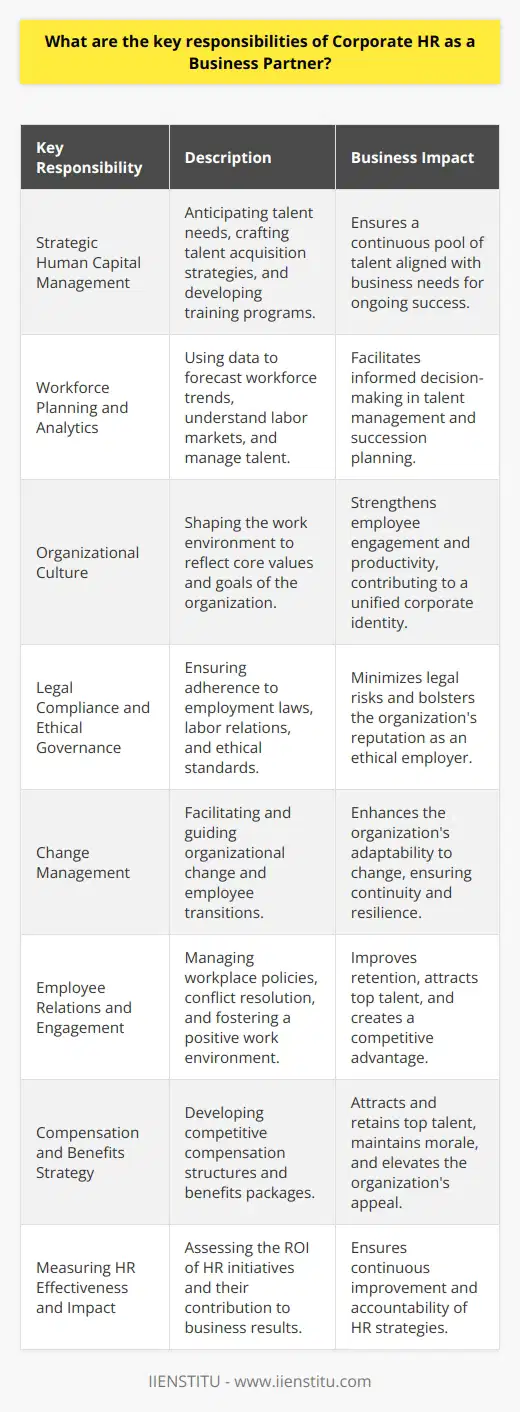
How does Human Resources Management contribute to the success of a business?
Human Resources Management (HRM) plays a pivotal role in the success of any business. HRM can be defined as the management of personnel within an organization, including the recruitment, selection, evaluation, and development of employees. It also encompasses the management of employee relations, compensation, health, safety, and employee engagement and wellbeing.
The main objective of HRM is to ensure that the organization has the right number of people, with the right skills, in the right place, at the right time, for the right cost. HRM is, therefore, a strategic partner in the business's success, as it helps ensure that the organization has the necessary people to achieve its business goals.
HRM contributes to the success of a business in several ways, including recruitment and selection, employee development and engagement, and compensation management. Recruitment and selection are essential to ensure that the right people are hired to work in the organization. Employee development and engagement, meanwhile, are essential for ensuring that employees are motivated and engaged in their work. Finally, compensation management is essential for ensuring that employees are adequately compensated for their efforts.
In addition to the direct contributions that HRM makes to the success of a business, it also has indirect benefits. For example, effective HRM can help cultivate a positive organizational culture, improving employee morale and engagement and ultimately leading to better business outcomes. It can also help to improve employee retention, reduce costs associated with high staff turnover, and ensure that employees are adequately trained and qualified for their roles.
In conclusion, HRM is a critical factor in the success of any business. It can help to ensure that the right people are recruited and selected, that employees are adequately engaged and developed, and that compensation is managed effectively. It can also have indirect benefits, such as improving employee morale and retention. Therefore, businesses should consider HRM as a strategic partner in their success.
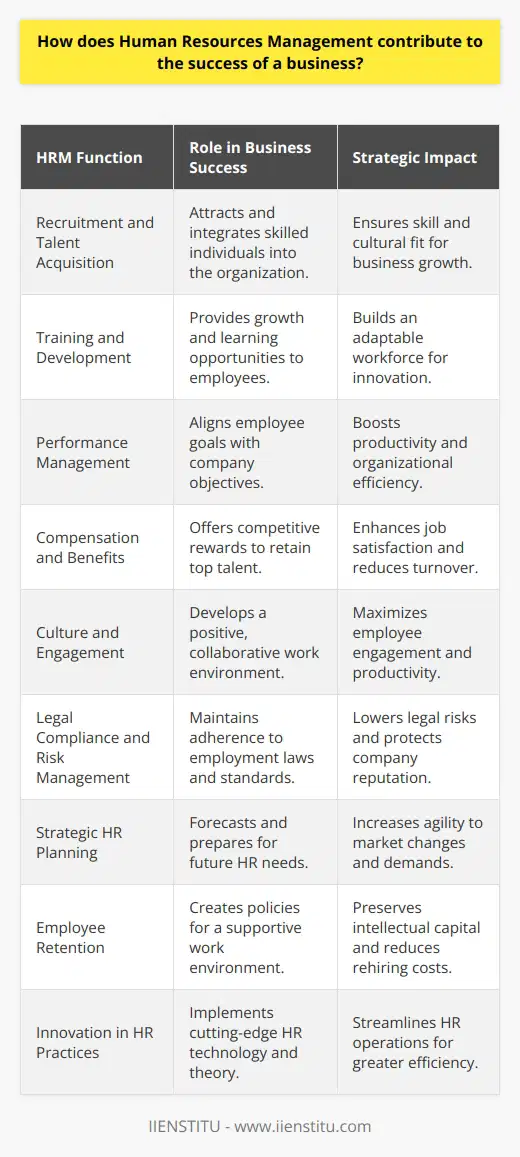
What are the benefits of Corporate HR as a Business Partner in maximizing Human Resources Management?
As the role of Human Resources Management (HRM) in the corporate world has become increasingly important in recent years, Corporate HR has emerged as a vital business partner in maximizing HRM. This article will outline some key benefits of Corporate HR as a business partner and explain how it can help businesses achieve their goals.
First, Corporate HR provides expertise in developing effective HR policies and procedures. Corporate HR has the experience and knowledge to help companies design and implement policies that align with their strategic objectives and help them meet their goals. Corporate HR can also guide the best ways to use their people resources and ensure that their HR policy is consistent and compliant with applicable laws and regulations.
Second, Corporate HR can help companies manage their employee data and analytics. By utilizing Corporate HR’s expertise in data analysis, companies can gain valuable insights into their workforce, allowing them to identify areas for improvement and develop effective strategies for managing their human resources. This data can also support decision-making and inform future HRM strategies.
Third, Corporate HR can assist with recruiting and staffing. Corporate HR can help companies identify and attract the most qualified candidates for their open positions. Additionally, Corporate HR can help companies develop effective onboarding and training programs to ensure that their new employees are well-equipped to succeed in their roles.
Lastly, Corporate HR can help companies develop effective strategies for managing their employee relations. Corporate HR can assist in developing effective strategies for communication, conflict resolution, and employee engagement. This can help companies foster an environment of trust and collaboration, which can lead to greater job satisfaction and higher morale.
In conclusion, Corporate HR provides numerous benefits to businesses as a business partner in maximizing HRM. By utilizing their expertise and insights, companies can ensure that their HR policies are effective, their workforce is managed efficiently, and their employee relations are managed effectively. In this way, Corporate HR can help businesses achieve their goals and create a culture of success.
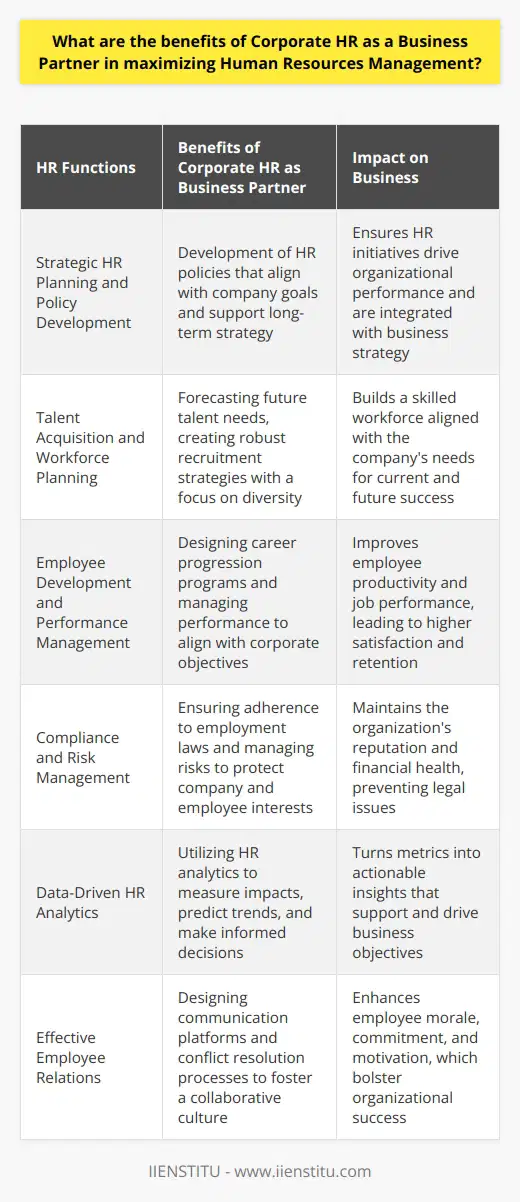
What is the difference between human resources business partner and human resources manager?
Role and Responsibilities
The fundamental difference between a Human Resources Business Partner (HRBP) and a Human Resources Manager (HRM) lies in their respective roles and responsibilities within an organization. HRBPs are primarily responsible for aligning human resources strategies with the organization's overall business goals, thus helping the organization achieve its objectives. In contrast, HRMs focus on overseeing the daily operations of the HR department, including recruitment, performance management, employee relations, and talent management.
Strategic vs. Operational Focus
HRBPs act as strategic partners to senior management, providing guidance on implementing organizational change, fostering employee engagement, and promoting talent development. They collaborate with different departments within the organization to understand their unique needs and develop tailor-made solutions. HRMs, on the other hand, have a more operational focus. They manage the HR team and ensure that the department is functioning efficiently and adhering to all relevant laws, regulations, and internal policies.
Scope of Influence
While both HRBPs and HRMs are critical to the success of an organization's human resources function, they differ in their scope of influence. HRBPs typically support a specific business unit or function, working closely with senior leaders to develop and implement HR strategies aimed at driving organizational performance. On the contrary, HRMs oversee the HR function across the entire organization, focusing on standardizing HR policies, ensuring compliance with local laws, and managing the HR department's budget and resources.
Skill Set
Another crucial difference between the two roles is the skill set required for each. HRBPs must possess strong strategic thinking capabilities, enabling them to analyze and identify opportunities for improvement within their business unit or function. They require excellent communication skills to effectively build relationships with senior leaders and advocate for HR initiatives. HRMs need to be well-versed in operational management, with a deep understanding of labor laws, HR policies, and best practices. They must also excel at managing and developing their HR teams to ensure the department functions effectively.
In conclusion, the roles of an HRBP and an HRM may overlap to some extent, but they differ significantly in terms of their focus areas, scope of influence, and required skill sets. While HRBPs concentrate on aligning HR strategies with business objectives, HRMs ensure the smooth functioning of the HR department within the organization. Both roles contribute to the organization's overall success by creating a positive work environment, attracting and retaining top talent, and fostering employee growth and productivity.
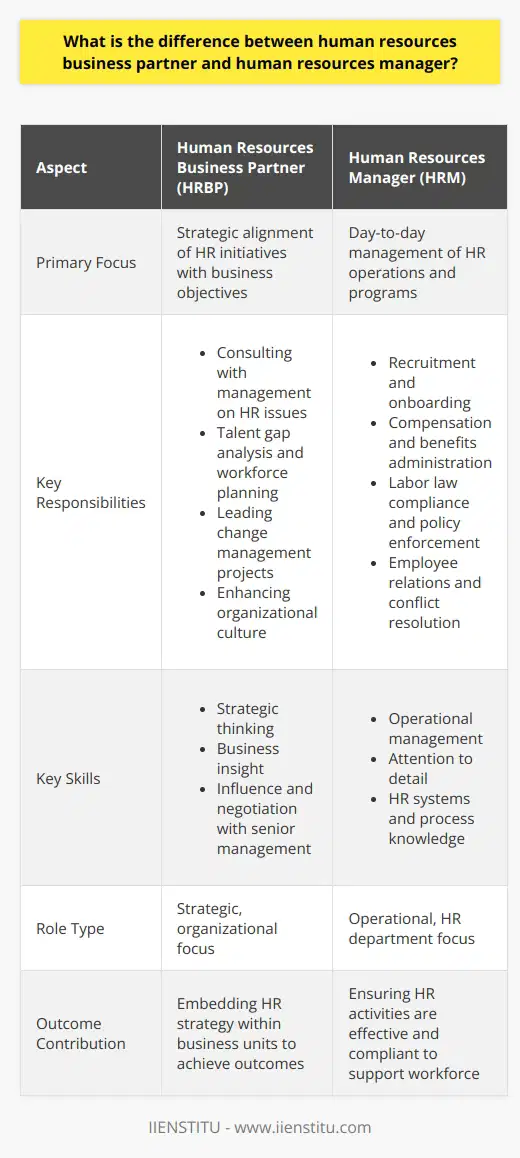
Which role is higher HR business partner or HR manager?
Role Comparison: HR Business Partner vs. HR Manager
Evaluating Responsibilities and Scope
To determine whether an HR business partner or an HR manager holds a higher position, we must first examine their respective responsibilities and scope within an organization. An HR business partner focuses on aligning HR initiatives with organizational goals, whereas an HR manager is responsible for overseeing the day-to-day operations of the HR department.
HR Business Partner: Strategic Alignment
The primary responsibility of an HR business partner is to establish and maintain the strategic alignment between the organization's goals and HR initiatives. They are tasked with understanding the business's needs, identifying gaps in the current HR strategy, and recommending improvements. Critical to this role is the ability to collaborate effectively with key stakeholders and implement data-driven solutions.
HR Manager: Operational Oversight
An HR manager, on the other hand, is responsible for overseeing the daily operational aspects of the HR department. Their role includes managing HR staff, implementing policies and procedures, ensuring compliance with labor laws, and handling employee relations issues. While an HR manager also contributes to strategic planning, their primary focus is on the management and administration of the HR function.
Nature of Work: Proactive vs. Reactive
The nature of work varies between an HR business partner and an HR manager. HR business partners are typically more proactive, as they actively seek out and anticipate opportunities for improvement within the organization. In contrast, HR managers are often more reactive, addressing day-to-day challenges and maintaining HR processes.
Degree of Influence: Strategic vs. Administrative
The degree of influence held differs significantly between these roles. HR business partners typically possess a higher degree of influence, as they consult with senior leadership and have input in key decisions pertaining to organizational strategy. HR managers, although crucial in their administrative function, primarily handle the implementation and enforcement of policies rather than their formation.
Conclusion: HR Business Partner as a Higher Role
In summary, the HR business partner role is generally considered higher than the HR manager position. This is due to the strategic nature of the HR business partner's responsibilities, their proactive approach to problem-solving, increased collaboration with senior leadership, and a greater degree of influence in organizational decision-making. Nonetheless, the two roles are interdependent, with HR managers ensuring the seamless execution of decisions made by HR business partners.
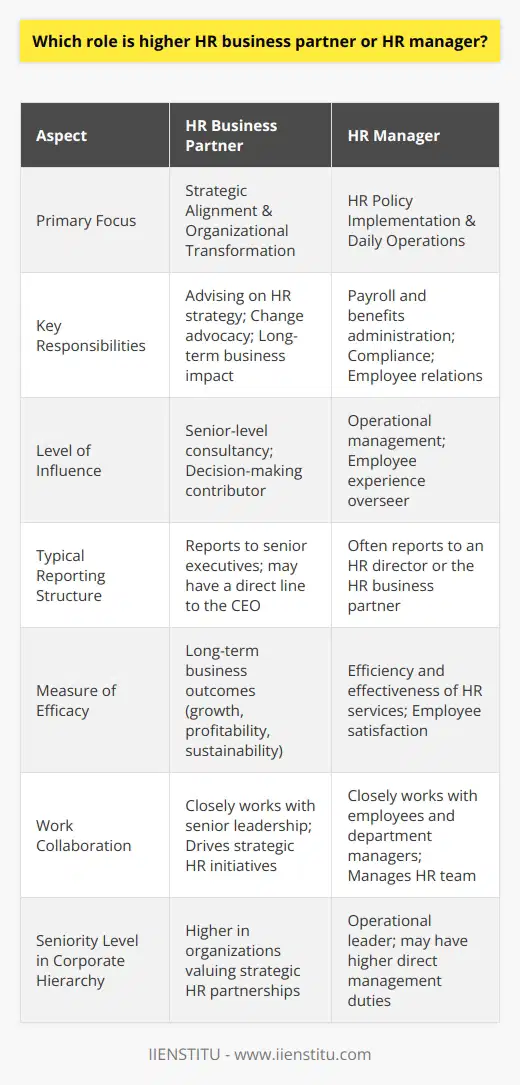
How does the HR business partner role help human resources to become a strategic partner of the organization?
Role of HR Business Partner
The HR business partner Role plays a crucial part in transforming human resources into a strategic partner within an organization. By collaborating closely with business leaders, HR business partners can develop and implement effective strategies that align with the organization's overall goals and objectives.
Alignment of Talent Management
One key aspect of the HR business partner's responsibility is to ensure the alignment of talent management strategies with the organization's long-term objectives. This includes working with management to identify workforce needs, effectively recruit and retain talent, and foster a culture that promotes continuous learning and development. As a result, the organization can capitalize on the unique skills and abilities of its employees, leading to improved efficiency, growth, and competitiveness.
Performance Management Enhancement
In addition to talent management, HR business partners play a pivotal role in enhancing performance management processes within the organization. Through their deep understanding of business operations and objectives, they are ideally positioned to identify key performance indicators (KPIs) and set appropriate targets for employees. By working closely with managers, HR business partners can provide the necessary tools, training, and support needed to achieve these targets, ultimately driving improved business performance.
Employee Engagement and Retention
An essential aspect of the HR business partner role is fostering employee engagement and retention. By finding ways to meaningfully connect employees' roles with the organization's overall strategy, HR business partners can increase job satisfaction and commitment levels among the workforce. Examples of such initiatives may include recognition programs, flexible work arrangements, or skill development opportunities. By improving employee engagement and retention, organizations can reduce turnover costs and maintain a productive workforce that contributes to achieving strategic objectives.
Improved Decision-Making
Lastly, the strategic partnership between HR and the organization enables better-informed decision-making. HR business partners have access to vital data on workforce trends, employee satisfaction, and talent management outcomes, which can inform resource allocation, organizational structure changes, and strategic plans. Through data-driven insights and their comprehensive understanding of the business landscape, HR business partners can help leaders make well-informed decisions that promote organizational growth and success.
In conclusion, the HR business partner role significantly contributes to the transformation of human resources into a strategic partner within an organization. By aligning talent management, enhancing performance management, fostering employee engagement and retention, and informing decision-making, HR business partners play an essential role in helping organizations achieve their strategic goals and objectives.
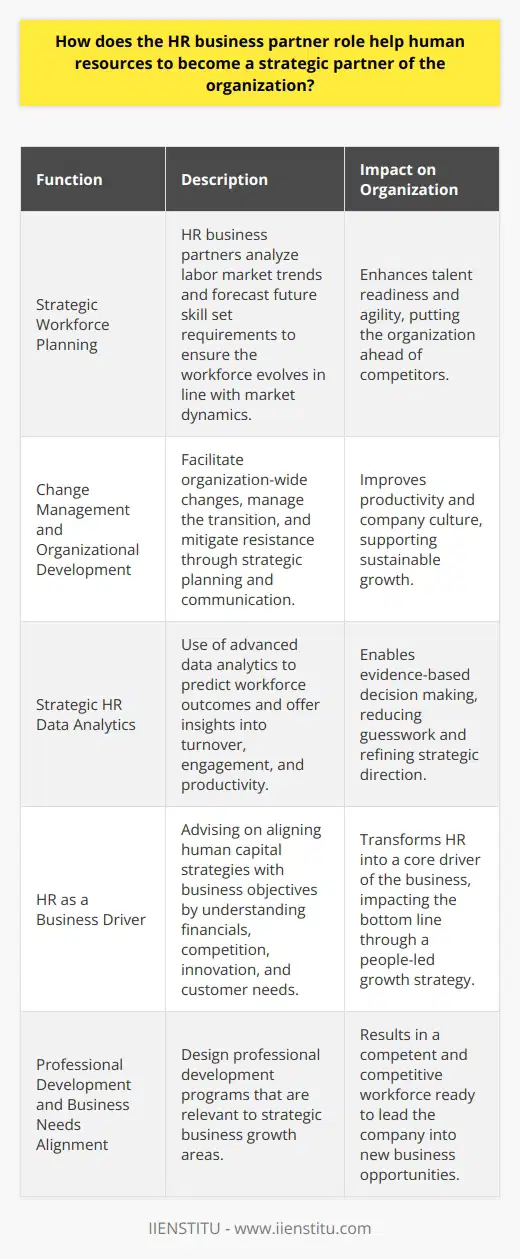
What is the role of the HR business partner in driving organizational change?
Role of the HR Business Partner
Facilitating Organizational Change
The HR business partner plays a crucial role in driving organizational change by ensuring that the human capital is strategically aligned with the organization's overall objectives. They act as an intermediary between employees and the management, enabling smooth communication and fostering a robust culture that can adapt to changes.
Managing Talent Acquisition and Development
A key responsibility of the HR business partner is to identify, attract, and retain talent that aligns with the organization’s goals. This involves recruiting employees with the necessary skills and cultural fit, as well as developing their competencies through training and development initiatives. By nurturing a strong talent pool, the HR business partner helps organizations stay competitive and respond effectively to market dynamics.
Creating and Implementing Change Strategies
The HR business partner is instrumental in designing and implementing change strategies that have a comprehensive impact on the organization. They collaborate with cross-functional teams to develop action plans that consider both short- and long-term objectives. This holistic approach ensures that the organization remains agile in a constantly evolving business environment.
Influencing Culture and Mindset
To drive change, the HR business partner must foster a culture of adaptability, innovation, and continuous improvement. This involves shaping the organization's values, beliefs, and practices to support change and build resilience. By promoting a growth mindset and encouraging employees to embrace change, the HR business partner paves the way for successful transformation efforts.
Promoting Collaboration and Communication
An essential aspect of driving organizational change is promoting collaboration and communication across all levels of the organization. The HR business partner ensures that there is a clear understanding of the reasons for change and the intended outcomes. Open and transparent communication channels help employees effectively navigate through the change process and facilitate a smooth transition.
Supporting Employee Well-being
The HR business partner is responsible for managing the impact of change on employees' well-being. By implementing comprehensive support systems, they ensure that employees can adapt to the new environment and overcome any stress or anxiety associated with organizational change. This support may include resources such as counseling services, educational workshops, and stress management programs.
In conclusion, the HR business partner plays a fundamental role in driving organizational change by aligning human capital with strategic objectives, managing talent acquisition and development, implementing change strategies, influencing culture and mindset, promoting collaboration and communication, and supporting employee well-being. Their expertise in managing both the strategic and human aspects of change helps organizations remain agile and successful in a constantly changing world.
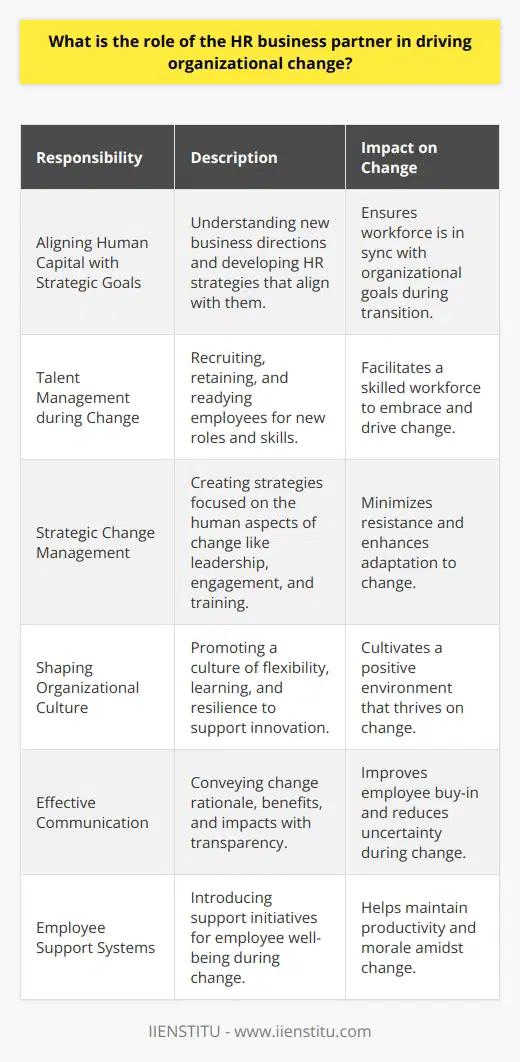
How can the HR business partner role facilitate the alignment of HR strategies with organizational goals?
Role of HR Business Partner
The HR business partner (HRBP) plays a crucial role in facilitating the alignment of HR strategies with organizational goals. They act as a liaison between the HR department and business units, ensuring that HR initiatives correspond with the strategic objectives of the organization.
Understanding Business Needs
One of the key responsibilities of an HRBP is to understand the business needs of the organization. This involves analyzing current business operations, identifying potential areas of improvement, and recommending specific HR strategies to support these needs. By doing so, the HRBP contributes to the overall success of the organization while ensuring that talent management aligns with business objectives.
Developing HR Initiatives
As an advocate for the organization’s goals, the HRBP develops HR initiatives that support the business strategy. These initiatives may include talent acquisition, performance management, and employee development programs. By implementing these strategies, the HRBP ensures that the organization has the necessary workforce to achieve its objectives.
Collaborating with Business Units
To ensure alignment, the HRBP actively collaborates with business unit leaders to identify their specific departmental goals and challenges. By working closely with these leaders, the HRBP can tailor HR initiatives to address the unique needs of each department. This collaborative approach ensures that HR strategies contribute directly to the achievement of organizational goals.
Monitoring and Adjusting HR Strategies
The HRBP also monitors the effectiveness of HR initiatives in achieving organizational objectives. This involves tracking key performance indicators (KPIs), collecting feedback from employees, and assessing the overall impact of the HR strategies on business performance. Based on these insights, the HRBP continuously refines and adjusts HR initiatives to better align with the organization's needs.
Conclusion
In conclusion, the HR business partner role significantly contributes to the alignment of HR strategies with organizational goals. By understanding business needs, developing HR initiatives, collaborating with business units, and monitoring the effectiveness of HR strategies, the HRBP ensures that the organization's talent management is both relevant and supportive of its objectives, ultimately driving success in the organization.
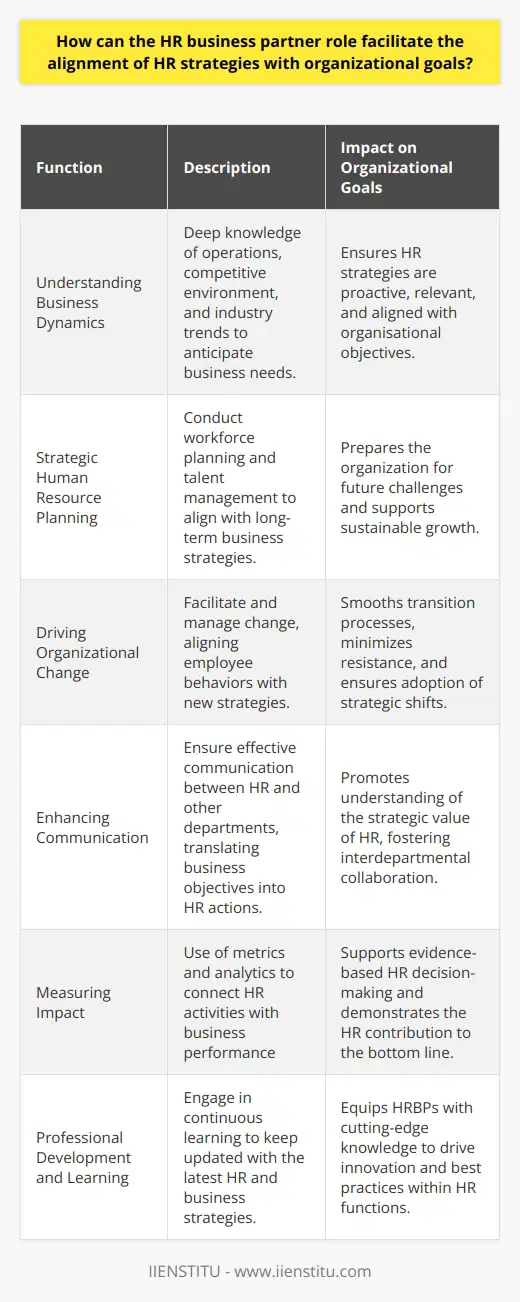
What are the critical skills and competencies required for an HR business partner to be effective in a modern organization?
Understanding Business Strategy
To be effective in a modern organization, an HR business partner must first possess a deep understanding of the organization's business strategy. This includes knowledge of the company's goals, target market, strengths, and culture.
Financial Acumen
Additionally, strong financial acumen is crucial for making informed decisions on personnel investments, workforce planning, and performance management. HR business partners need to assess financial implications and translate these into strategic HR actions.
Influencing Skills
Effective communication and influencing skills are critical in building trust and credibility with senior leaders and employees. HR business partners must be able to persuasively present their ideas while fostering collaboration, consensus, and change within the organization.
Operational Expertise
An HR business partner must possess operational expertise to optimize business processes, identify inefficiencies, and implement continuous improvement practices. This includes knowledge of talent acquisition, learning and development, performance management, and employee engagement.
Data-Driven Decision-Making
In a modern organization, HR business partners must be adept at leveraging data analytics to make informed decisions. This requires the ability to collect, analyze, and interpret data on talent trends, capacity planning, workforce performance, and employee attrition.
Change Management
Change management skills are essential, as HR business partners often play a central role in facilitating organizational change efforts. This includes helping employees adapt to new processes or technologies, maintaining morale during transitions, and ensuring alignment with overall strategic goals.
Cultural Awareness
Finally, cultural awareness and sensitivity to diversity are crucial in today's global business environment. HR business partners must be able to navigate different cultural contexts, considering the unique perspectives, expectations, and communication styles of diverse individuals and teams.
In summary, the effectiveness of an HR business partner in a modern organization depends on their ability to understand and contribute to business strategy, possess financial acumen, communicate effectively with influence, demonstrate operational expertise, leverage data for decision-making, manage change, and navigate cultural differences. These skills and competencies enable HR professionals toa align people and processes with the organization's objectives, fostering long-term success.

What is the role of the HR business partner in talent management and development?
Role of HR Business Partner in Talent Management
The Human Resources (HR) business partner plays a critical role in talent management and development, contributing to the organization's overall success. Through strategic collaboration and effective communication with organizational leaders, HR business partners actively participate in talent identification, recruitment, and retention.
Identification and Recruitment
The HR business partner aids in identifying potential talent by collaborating with department managers and utilizing various recruitment tools, such as job postings, social media, and professional networking platforms. They assess candidates' skills, qualifications, and fit with the organization's culture, ensuring that the talent pool aligns with the company's strategic objectives. In doing so, the HR business partner contributes to the development of a skilled workforce capable of achieving organizational goals.
Performance Management and Development
An essential aspect of talent management involves monitoring performance and implementing measures to optimize employee development. The HR business partner supports this process by designing effective evaluation methodologies and conducting regular performance assessments. By providing constructive feedback to employees, opportunities for growth and development are identified, promoting continuous improvement within the workforce.
Training and Skill Enhancement
A key aspect of talent development is nurturing employees' skills and knowledge. The HR business partner assumes responsibility for identifying gaps in existing competencies and developing targeted training programs, ensuring that employees are adequately equipped to meet their role requirements. Through these initiatives, HR business partners contribute to the continuous improvement of the organization's human capital.
Succession Planning
The HR business partner also contributes significantly to strategic succession planning, which involves identifying and developing potential leadership talent. By facilitating the growth of high-potential employees through targeted development activities, the HR business partner prepares these individuals for future leadership roles, ensuring the continued success of the organization.
Ultimately, the HR business partner's role in talent management and development is multifaceted, encompassing activities related to recruitment, performance management, training, and succession planning. By leveraging their expertise in human resources management, HR business partners ensure that the organization possesses the talent necessary to achieve its strategic objectives and maintain a competitive advantage in today's ever-evolving business landscape.
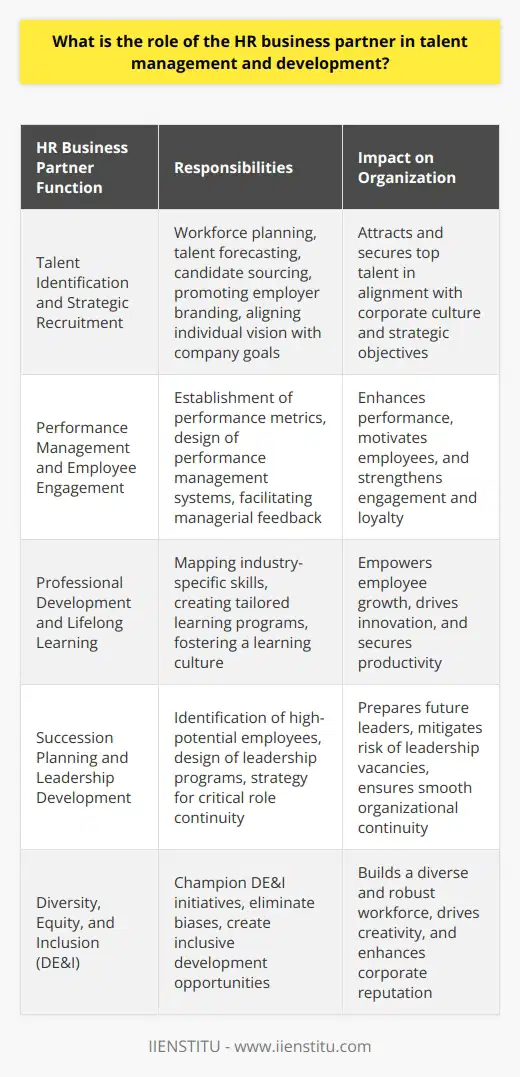
How do HR business partners influence organizational culture and employee engagement?
Role of HR Business Partners
HR business partners (HRBPs) play a crucial role in shaping organizational culture and fostering employee engagement. These professionals work closely with top management, providing informed guidance and strategic solutions to create a positive work environment that promotes employee satisfaction and business growth.
Driving Organizational Culture Change
To influence organizational culture, HRBPs must first understand the current state of the company, including its values, beliefs, and norms. They then identify areas requiring improvement and devise targeted strategies for change. Through effective communication and collaboration with executive leadership, HRBPs can align the company's culture with its strategic goals, ensuring that employees share a common vision and sense of purpose.
Creating Inclusive and Diverse Workplaces
Another way HRBPs impact organizational culture is by advocating for inclusion and diversity. By promoting equitable hiring practices and fostering a welcoming work environment, HRBPs can help minimize biases and ensure that employees of all backgrounds feel valued and respected. This increased sense of belonging and unity contributes to a more cohesive and dynamic organizational culture.
Boosting Employee Engagement
HRBPs also influence employee engagement by implementing programs and policies that address the various factors affecting employee morale and motivation. They may design performance management systems that offer timely feedback, establish reward and recognition programs, or support opportunities for professional development. By catering to employees' diverse needs and aspirations, HRBPs help to build a committed and engaged workforce.
Encouraging Open Communication
Open communication is vital for employee engagement, and HRBPs facilitate this by providing channels for employees to express their opinions and concerns. By involving employees in decision-making processes and providing transparent information, HRBPs demonstrate the company's commitment to improving the employee experience. This encourages employees to engage more actively in their work and contribute to the company's success.
Fostering Psychological Safety
Lastly, HRBPs help to create a psychologically safe environment, where employees feel comfortable taking risks, sharing ideas, and learning from mistakes. This is achieved by promoting trust, empathy, and support among team members, thus nurturing a culture of innovation, collaboration, and continuous learning.
In summary, HR business partners significantly influence organizational culture and employee engagement by driving necessary culture changes, advocating for inclusion and diversity, designing strategies to boost employee morale and motivation, encouraging open communication, and fostering trust and psychological safety. As such, they are vital contributors to the overall success and sustainability of an organization.
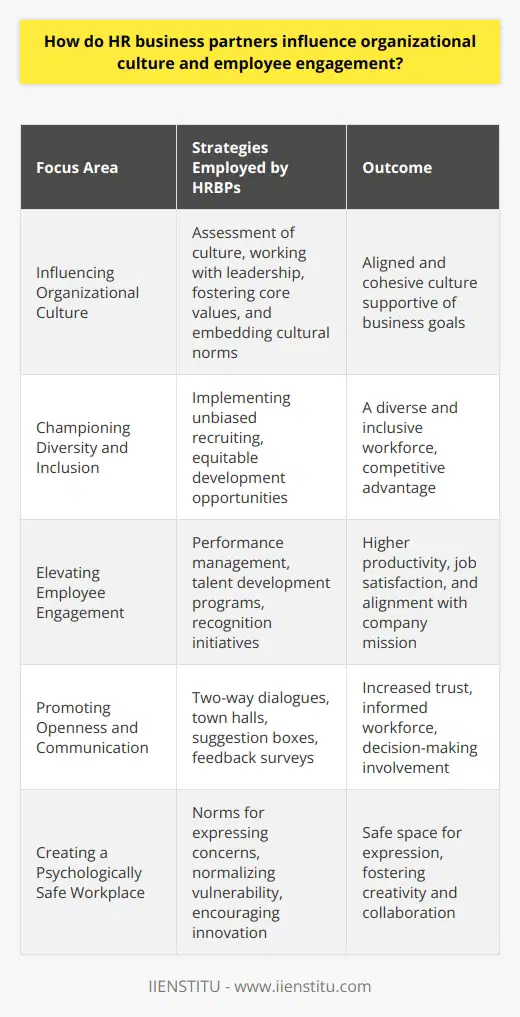
What are the best practices for HR business partners in facilitating effective communication between employees and management?
Understanding Employee Needs
Effective communication between employees and management begins with understanding employee needs. Best practices for HR business partners in facilitating this communication include actively listening to employee concerns, facilitating empathy and understanding to encourage discussions, and promoting a blame-free culture where individuals can openly share their thoughts and ideas.
Promoting Open Dialogue
One crucial aspect of communication is promoting open dialogue between employees and management. HR business partners can use various tools and techniques such as regular one-on-one meetings, feedback sessions, and team-building activities to bridge the communication gap. Offering anonymous communication channels like suggestion boxes or online platforms can also help in ensuring the ease of communication.
Training and Development
Training and development programs can significantly impact employee morale and improve communication skills. HR business partners should work closely with managers to identify training needs and develop tailored programs which focus on enhancing interpersonal skills, promoting emotional intelligence, and improving active listening. Continuous education opportunities should also be available to help employees develop professionally and maintain effective communication.
Transparent Communication Channels
Clear, transparent communication channels are vital to avoid misunderstandings, confusion, and disconnection between employees and management. HR business partners can implement comprehensive communication policies that outline the appropriate methods for information sharing, such as regular company updates, team meetings, or official company emails. Implementing modern communication tools such as intranets, workplace messaging apps, or project management platforms can promote easy, real-time communication among team members.
Recognizing and Rewarding Feedback
Recognizing and rewarding employee feedback positively impacts motivation and encourages open communication. HR business partners should work with managers to create reward systems that recognize employee input, such as regular town-hall meetings where employees’ contributions can be highlighted, or employee recognition awards. Implementing incentive programs that reward employees for providing constructive feedback or suggesting innovative ideas can effectively strengthen communication channels and promote cooperation between management and employees.
In conclusion, facilitating effective communication between employees and management requires a proactive approach from HR business partners that ensures employees' needs are met, open dialogue is encouraged, necessary training and development initiatives are provided, transparent communication channels are established, and employee feedback is recognized and rewarded. By adopting these best practices, HR business partners can effectively bridge the communication gap and foster a positive work environment where employees and management can openly share ideas and collaborate towards a common goal.
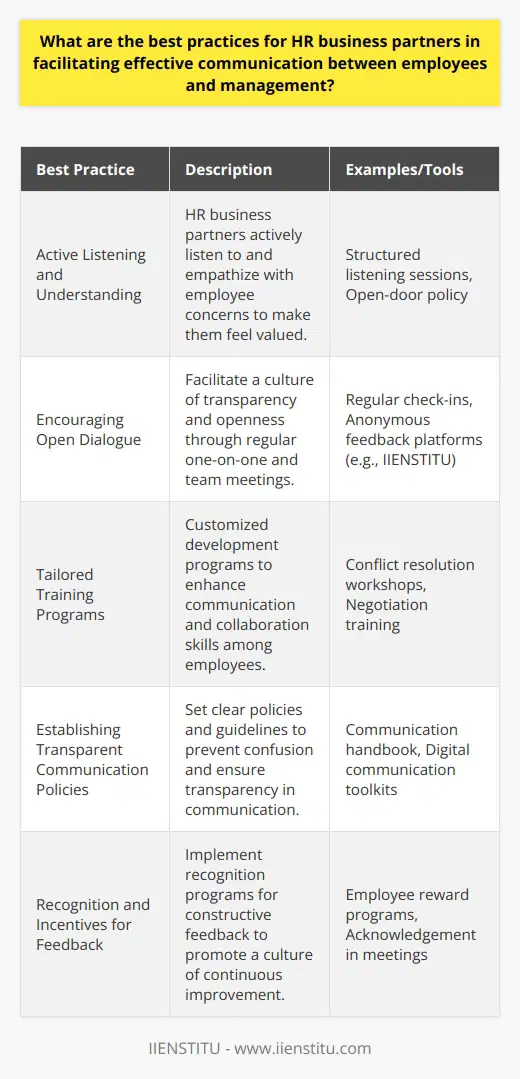
What is the role of HR professionals in human resource management?
Role of HR Professionals in Human Resource Management
Core Functions and Responsibilities
HR professionals play a significant role in executing human resource management within an organization. They are responsible for ensuring efficient personnel practices, developing a positive workplace culture, and fostering employee productivity. This involves various tasks, such as recruitment and selection, training and development, performance management, compensation management, and employee relations.
Recruitment and Selection
One of the primary roles of HR professionals is to manage the process of recruitment and selection. They are responsible for the identification of potential candidates, conducting interviews, and selecting the most suitable applicants to join the organization. This process involves evaluating job requirements and finding the right candidates with the appropriate skill sets and qualifications to meet those requirements.
Training and Development
HR professionals are also in charge of designing and implementing training and development programs for employees within the organization. This crucial function ensures that employees have the necessary skills and knowledge to perform their roles effectively. These initiatives include onboarding programs for new hires, providing ongoing training opportunities for existing staff, and crafting career development plans to assist with employee retention.
Performance Management
Ensuring that employees are working efficiently, HR professionals monitor and evaluate performance to drive overall productivity. They coordinate performance appraisals, provide constructive feedback, and establish performance objectives. Performance management also entails addressing underperformance issues through a supportive approach, including coaching or additional training.
Compensation Management
Another vital function of HR professionals is the management of employee compensation, including salaries, benefits, and incentives. They must devise and implement a competitive compensation structure that attracts, retains, and motivates employees. This includes conducting market research, developing pay scales, and managing benefit programs to ensure employee satisfaction.
Employee Relations
Maintaining positive employee relations is essential for creating an engaged workforce and resolving workplace conflicts. HR professionals serve as the liaison between employees and management by addressing complaints, offering guidance on company policies, and fostering a culture of open communication. They are instrumental in promoting a harmonious work environment and preventing potential legal issues.
Conclusion
In summary, HR professionals play an instrumental role in human resource management, contributing to the organization's success. Their diverse responsibilities encompass recruitment, training, performance management, compensation, and employee relations, all of which aim to create a positive, productive workspace. By efficiently executing these tasks, HR professionals significantly improve an organization's overall performance and enhance employee satisfaction.
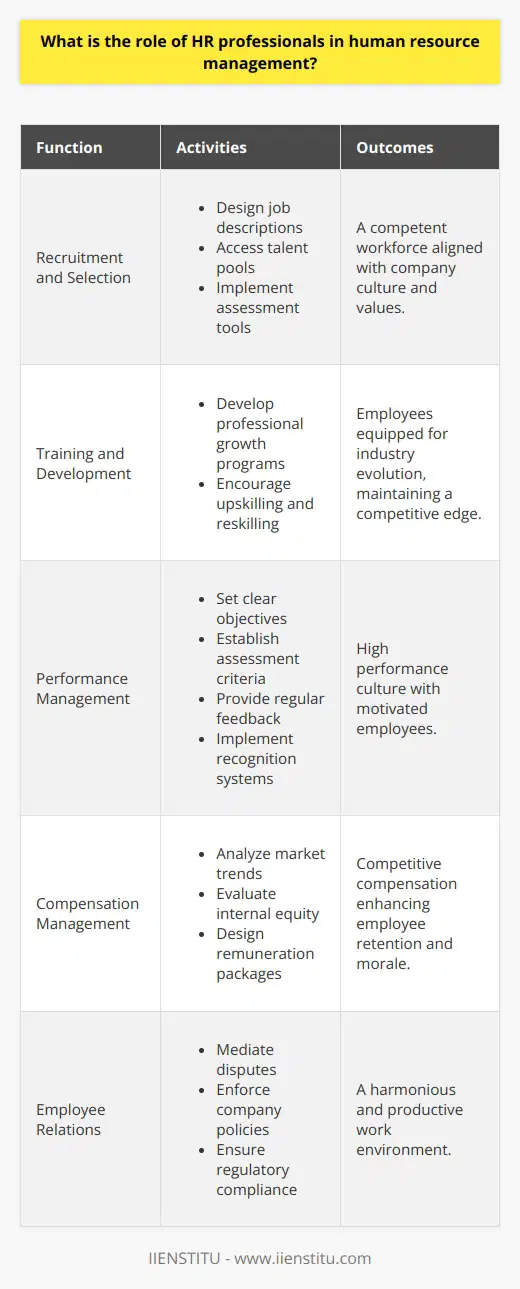
How can the HR business partner role help the organization maximize productivity?
Role of HR Business Partner in Productivity Enhancement
Understanding Organizational Goals
The HR business partner (HRBP) plays a vital role in helping the organization maximize productivity by aligning human resources strategies and policies with the organization's overall goals. They bridge the gap between HR and other business units, ensuring that HR expertise is effectively utilized in support of the organization's objectives.
Workforce Planning and Talent Management
A key responsibility of the HRBP is workforce planning and talent management to ensure the right people are in the right roles at the right time. This involves anticipating future skills requirements, identifying talent gaps, and proactively implementing strategies such as training and development, succession planning, and employee engagement initiatives to address any talent shortages.
Performance Management
To maximize productivity, HRBPs contribute to the design and implementation of performance management systems, which enable the organization to set expectations, measure employee performance, and provide feedback. This helps to create a culture of continuous improvement and enables the organization to identify high-performers and address underperformance, leading to increased overall productivity.
Employee Engagement and Retention
A critical aspect of the HRBP's role is fostering a positive work environment that motivates and engages employees. They collaborate with managers to establish employee engagement initiatives, such as recognition and reward programs, flexible work arrangements, and opportunities for career growth. These initiatives contribute to higher employee satisfaction, outleading to increased commitment and reduced turnover, ultimately maximizing productivity.
Data-Driven Decision Making
Another crucial aspect of the HRBP role is utilizing data and analytics to identify trends, improve processes, and make informed decisions. They analyze metrics such as employee turnover, absenteeism, and productivity data to identify areas for improvement and implement evidence-based interventions. This data-driven approach enables the organization to develop targeted strategies to enhance productivity and drive optimal performance.
In conclusion, the HR business partner's role in maximizing productivity is multifaceted, encompassing workforce planning, performance management, employee engagement, and data-driven decision making. By working closely with business units to align HR strategies with organizational goals, HRBPs can significantly contribute to the overall success and productivity of the organization.
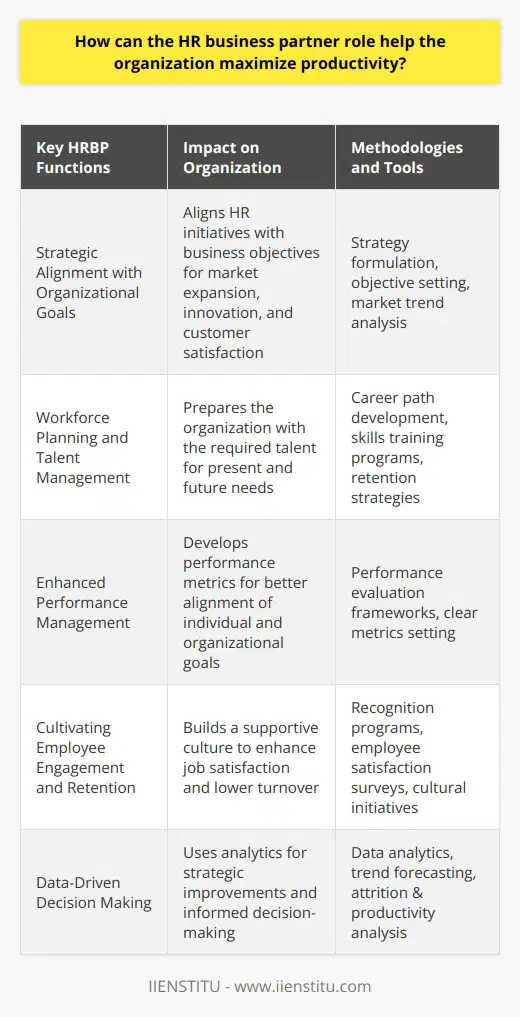
What is the corporate role of human resource management?
Role of HRM in Corporations
The corporate role of human resource management (HRM) is central in ensuring an organization's success. Its primary function is to manage human capital, a company's most valuable resource, and to align employees' skills, efforts, and motivation with the organization's goals and objectives. HRM accomplishes this through various activities, including recruitment, selection, training, development, performance management, and employee relations.
Effective Recruitment and Selection
HRM plays a critical role in attracting and hiring the best talent for various job positions in the organization. The HR department develops job descriptions, advertises vacancies, screens candidates, conducts interviews, and selects the best-qualified employees to increase the likelihood of organizational success.
Training and Development Programs
HRM ensures employee growth and optimum performance by conducting regular training and development programs. These programs nurture and enhance an employee's skills, knowledge, and abilities, enabling them to meet their performance expectations and contribute to the company's overall progress.
Performance Management System
To ensure employees meet their full potential, HRM establishes and maintains an effective performance management system. This system involves setting performance goals, providing regular feedback, conducting appraisals, and implementing measures to improve employee performance.
Nurturing Employee Relations
Building healthy employee relationships is essential for a positive work environment. HRM develops policies that safeguard employees' interests and rights, fosters open communication, resolves conflicts, and ensures fair treatment for all employees.
Compensation and Benefits Administration
HRM designs competitive compensation and benefits packages to attract, retain, and motivate employees. This includes setting salary structures, offering incentives, and managing employee benefits such as health insurance, retirement plans, and paid time off, all within legal regulations and corporate policies.
Legal Compliance
Navigating the numerous legal requirements and regulations that apply to employment is an important HR function. The HR department ensures compliance with labor laws, anti-discrimination legislation, equal opportunity policies, and health and safety standards, mitigating the risk of litigation and promoting an ethical workplace.
In conclusion, the corporate role of human resource management is crucial for organizations to thrive. Through effective recruitment, staff development, a robust performance management system, nurturing employee relations, and administering compensation and benefits, HRM builds a skilled and motivated workforce that contributes to the overall success of the company.
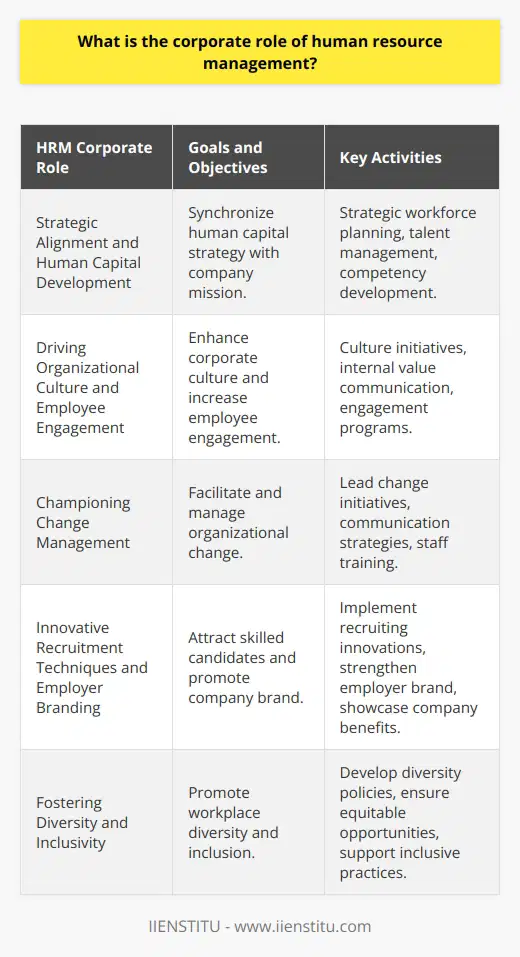
What is the role of the HR business partner in driving organizational change?
Role of the HR Business Partner
Understanding Change Management
The HR business partner plays a vital role in driving organizational change by comprehending the change management process. They identify the need for change, envision a desired future state, and strategize the actions for achieving the transformation. This understanding enables HR professionals to support the organization through the various stages of change effectively.
Guiding Leadership and Employees
HR business partners guide leadership and employees on how to embrace new practices, systems, or culture shifts. They facilitate communication between relevant stakeholders, ensuring that all individuals are well-informed about the nature of the change and its implications. Additionally, HR professionals offer essential coaching and training to help employees develop the skills necessary to adapt effectively.
Addressing Employee Concerns
As employees often express concerns or resistance to change, HR business partners act as mediators to address and mitigate these reactions. They actively listen to employee concerns and provide solutions to address these, fostering a sense of empathy, understanding, and trust within the organization. This approach positively impacts employee buy-in and engagement in the change process.
Promoting Organizational Culture
Organizational culture plays a significant role in shaping employee behavior and attitudes, and the HR business partner ensures it aligns with the desired change. They create a supportive environment that reinforces the change objectives and values, ultimately leading to a more seamless transition. Also, by continuously assessing and monitoring the cultural impact of change initiatives, HR professionals ensure long-lasting, successful change.
Evaluating Change Outcomes
Lastly, an HR business partner's role in driving organizational change includes evaluating the success of the change initiatives. They identify relevant metrics to track progress and measure the effectiveness of the changes implemented. By analyzing the data, HR professionals identify areas that require improvement and make recommendations for necessary adjustments, ensuring the organization remains agile and adaptable to future changes.
In conclusion, HR business partners play an instrumental role in driving organizational change by understanding and managing the complexities surrounding these transitions. They guide and support leadership and employees, address employee concerns, promote an adaptive organizational culture, and evaluate the effectiveness of the change initiatives. These efforts ensure successful and sustainable change, fostering growth and development for the organization.

How can the HR business partner role facilitate the alignment of HR strategies with organizational goals?
Role in Strategy Development
One way the HR business partner role can facilitate the alignment of HR strategies with organizational goals is by actively participating in the strategy development process. By understanding the organization's overarching objectives, HR business partners can then develop human resource policies, processes, and practices that are explicitly designed to support those objectives.
Bridging the Gap between HR and Business
HR business partners bridge the gap between human resources and other business functions by collaborating with department heads and managers to assess the workforce's current skill sets, identify talent gaps, and develop action plans for addressing those gaps. Through this partnership, HR strategies are designed to support the needs of the business units and contribute directly to organizational goals.
Training and Development
Another aspect of the HR business partner role that contributes to aligning HR strategies with organizational goals is the focus on employee training and development. HR business partners can assess the existing skill sets of employees and identify development opportunities to increase organizational capacity. By investing in employee training and development, organizations can better achieve their strategic objectives by fostering a workforce that is competent, innovative, and adaptable.
Performance Management and Employee Engagement
Aligning HR strategies with organizational goals also involves the HR business partner's role in performance management and employee engagement. HR business partners can design and implement performance management systems that link employee performance and objectives with the organization's overall goals. This ensures that employees are aligned with the organization's strategy and motivated to work towards its success. Additionally, HR business partners can foster employee engagement through communication, recognition, and feedback, leading to a more motivated and committed workforce, which is fundamental to achieving organizational goals.
Succession Planning
Finally, HR business partners can facilitate the alignment of HR strategies with organizational goals through effective succession planning. By identifying and grooming future leaders within the organization, the HR business partner ensures that the company is prepared to face inevitable organizational changes and challenges. Succession planning contributes to the long-term sustainability and success of an organization, ensuring that its goals will continue to be met even as leadership changes occur.
In conclusion, the HR business partner role effectively aligns HR strategies with organizational goals through its involvement in strategy development, bridging the gap between HR and business functions, focusing on employee training and development, engaging employees in performance management, and ensuring effective succession planning. This alignment results in a highly skilled, motivated, and committed workforce, supporting organizational success and growth.

How do HR business partners influence organizational culture and employee engagement?
Role of HR Business Partners
HR business partners (HRBPs) play a vital role in shaping organizational culture and fostering employee engagement. They influence these aspects by developing and implementing human resource policies, practices, and strategies that align with the organization's goals and values.
Promoting Healthy Organizational Culture
HRBPs are responsible for creating an inclusive and supportive environment for all employees. By forming policies in line with diversity, equity, and inclusion, HRBPs make sure that all employees feel welcomed and respected. They also ensure that the workplace is free from harassment and discrimination while engaging in open communication and collaboration.
Encouraging Employee Engagement
HRBPs foster employee engagement by designing innovative and engaging employee programs. They serve as a link between the management and employees, ensuring that employee concerns and feedback are properly addressed. By promoting a culture of growth and development, HRBPs facilitate opportunities for skill development, continuous learning, and career advancement, leading to higher levels of employee commitment and loyalty.
Attracting and Retaining Talent
HRBPs influence organizational culture by attracting top talent and retaining skilled professionals. They create competitive compensation and benefits packages that appeal to potential and current employees. Moreover, they develop effective onboarding programs and mentorship initiatives, ensuring new employees feel integrated into the company culture.
Developing Leadership
HRBPs contribute to nurturing leadership within the organization by offering leadership development programs and trainings. These initiatives help cultivate strong leaders who embody company values and positively influence the overall organizational culture. This also leads to managers with the skills necessary to engage, inspire, and motivate their teams.
Fostering Employee Well-being
Employee well-being is a crucial aspect to consider for HRBPs. By developing wellness programs and ensuring work-life balance, they create a healthy environment for employees to thrive in. This boosts employee satisfaction and engagement, resulting in increased productivity and organizational success.
In conclusion, HR business partners play a significant role in influencing organizational culture and employee engagement. By developing inclusive policies, promoting employee engagement, attracting and retaining talent, fostering leadership and prioritizing employee well-being, they pave the way for a thriving and successful organization.

What is the role of the HR business partner in fostering diversity and inclusion in the workplace?
Role of the HR Business Partner in Diversity and Inclusion
Understanding the Concept
The HR business partner plays a pivotal role in fostering diversity and inclusion in the workplace by facilitating an environment that embraces and values the uniqueness of every individual. This type of environment promotes productivity, creativity, and morale among employees, leading to better business outcomes.
Strategizing for Diversity and Inclusion
The HR business partner collaborates with company leadership to establish a clear strategy for developing and maintaining a diverse and inclusive work environment. This includes defining diversity and inclusion goals, creating policies that protect employee rights, and investing in training and development programs that enhance diversity awareness and promote inclusive behavior.
Recruitment and Selection
To build a diverse workforce, the HR business partner ensures that recruitment and selection processes are designed to attract and hire employees from a wide range of backgrounds and skill sets. This includes leveraging a wide range of recruitment channels, conducting unbiased interviews, and using fair assessment methods to evaluate candidates.
Employee Development and Retention
The HR business partner drives employee engagement and retention by ensuring that personal and professional development opportunities are tailored to the diverse needs of employees. This includes offering mentorship programs, facilitating networking and collaboration, and ensuring that the organization's culture and values are consistently aligned with diversity and inclusion goals.
Addressing Bias and Discrimination
One of the crucial responsibilities of the HR business partner is to monitor and address any instances of bias or discrimination within the workplace. This includes investigating complaints, taking appropriate action to resolve issues, and implementing initiatives to educate employees on the importance of diversity and inclusion.
Measuring Success and Continual Improvement
Finally, the HR business partner continually evaluates the success of the organization's diversity and inclusion efforts by tracking relevant metrics and adjusting strategies based on the findings. By using data-driven insights, the HR business partner can identify areas for improvement, ensure that resources are allocated effectively, and ultimately, foster a more diverse and inclusive workplace.
In conclusion, the HR business partner plays an essential role in promoting diversity and inclusion within the workplace. Through strategic planning, fair recruitment and selection processes, employee development initiatives, and regular evaluation and improvement, HR business partners contribute to an inclusive and diverse work environment that benefits both employees and the organization as a whole.
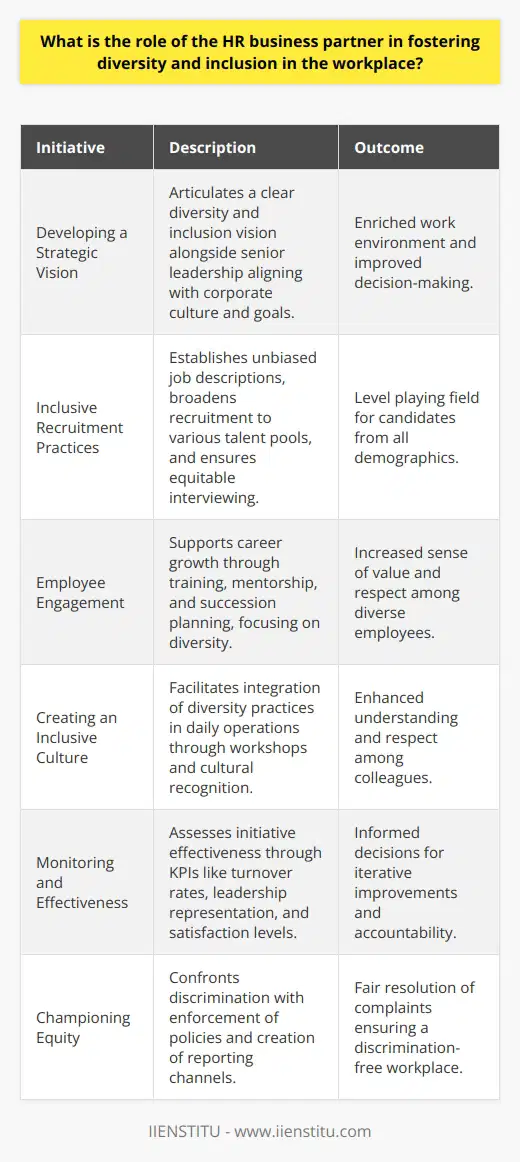
How does the HR business partner collaborate with other organizational functions and stakeholders to achieve business objectives?
Collaboration with Organizational Functions
The Human Resources (HR) business partner plays a crucial role in facilitating collaborations with various organizational functions and stakeholders, aiming to achieve the company's overall business objectives. By partnering with departments such as Finance, Operations, and Marketing, the HR business partner can contribute to strategic decision-making and foster synergies across the organization.
Building Rapport and Communication
A key aspect of the HR business partner role is building and maintaining strong relationships with different stakeholders in the organization. Effective communication channels facilitate collaboration, allowing for a smooth exchange of ideas and knowledge on business priorities. Understanding stakeholder expectations and concerns helps HR business partners align talent management initiatives with broader organizational goals.
Aligning Talent Management Initiatives
By collaborating with various departments, the HR business partner ensures that talent management initiatives are aligned with the company's overall strategy. This includes talent acquisition, learning and development, performance management, and succession planning. A joint effort to refine these processes ensures that the organization attracts, develops, and retains high-performing employees who contribute to achieving business objectives.
Promoting Organizational Culture
The HR business partner works with other functions and stakeholders to foster a strong organizational culture. This includes reinforcing values, expectations, and behaviors that drive business success. By collaborating with management and employees across diverse functions, HR business partners can ensure that the company's cultural DNA is embodied in all aspects of decision-making.
Supporting Change Management
In a rapidly evolving business environment, change is a constant factor. HR business partners collaborate with other organizational functions to support effective change management initiatives. By providing expertise in areas such as communication, training, and employee support, HR business partners can help ensure seamless transitions during periods of transformation.
Facilitating Cross-functional Projects
HR business partners often participate in cross-functional projects, bringing their unique perspective and expertise to the table. This collaboration allows for the development of well-rounded strategic initiatives that consider the entire organization's needs and perspectives, resulting in more effective and comprehensive solutions to business challenges.
In conclusion, the HR business partner's collaboration with other organizational functions and stakeholders is vital to achieving business objectives. By building rapport and communication, aligning talent management initiatives, promoting organizational culture, supporting change management, and facilitating cross-functional projects, HR business partners can play an instrumental role in driving organizational success.
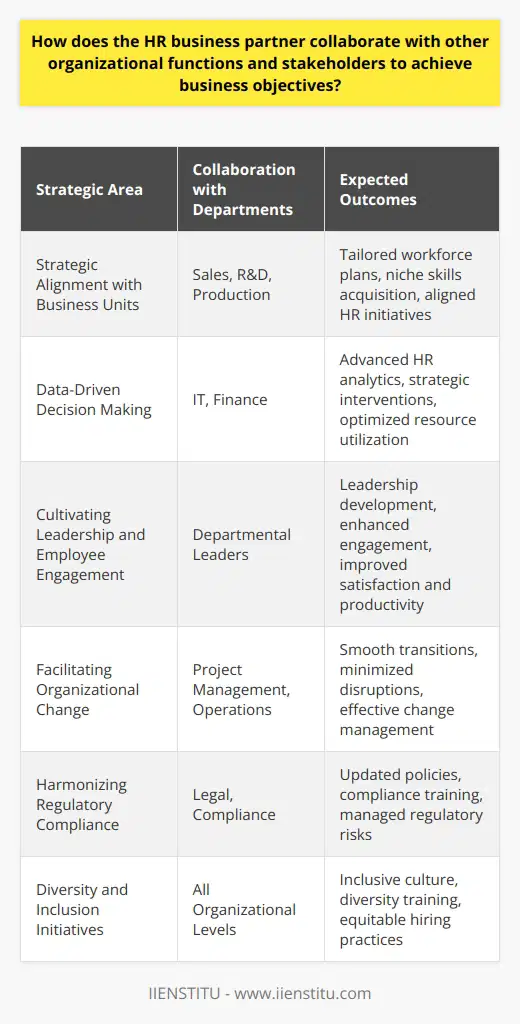
What are the key challenges faced by HR business partners and how can they overcome them to drive organizational success?
Challenges Faced by HR Business Partners
One critical challenge faced by HR business partners (HRBPs) is engaging and retaining talent to promote organizational success. To address this, HRBPs can utilize various strategies, such as fostering a positive culture, offering continuous professional development opportunities, and implementing robust reward systems that align with employee preferences and market trends.
Adapting to Technological Innovations
Another challenge HRBPs face is the need to adapt to emerging technological innovations in HR, such as artificial intelligence, data analytics, and automation. To overcome this challenge, HRBPs must continuously enhance their technical skills and cultivate a mindset of growth and adaptability to harness the transformative (and disruptive) potential of technology.
Managing Dynamic Regulatory Changes
HRBPs also encounter challenges in managing dynamic regulatory environments, particularly with regards to labor laws, data protection, and diversity and inclusion policies. To overcome this, HRBPs must maintain up-to-date knowledge of relevant regulations, foster strong relationships with legal or regulatory authorities, and develop compliance frameworks that both mitigate risk and enhance organizational agility.
Promoting Diversity and Inclusion
Promoting diversity and inclusion remains a critical challenge for HRBPs, especially given the increasing focus on nurturing diverse and inclusive workplaces to fuel innovation and competitiveness. HRBPs can overcome this challenge through targeted recruitment, training, and mentorship programs, as well as by fostering a culture of respect, psychological safety, and allyship.
Aligning HR Strategy with Business Requirements
Finally, HRBPs face the challenge of effectively aligning HR strategy with broader business requirements to drive organizational success. To overcome this challenge, HRBPs can employ practices such as cross-functional collaboration, robust data analysis to identify workforce trends and skills gaps, and fostering organizational agility to effectively respond to ever-evolving business landscapes.
In conclusion, by addressing these challenges proactively and strategically, HRBPs can contribute significantly to the success of their organizations, providing enhanced employee engagement, effective compliance management, and robust HR strategy that supports broader business objectives.
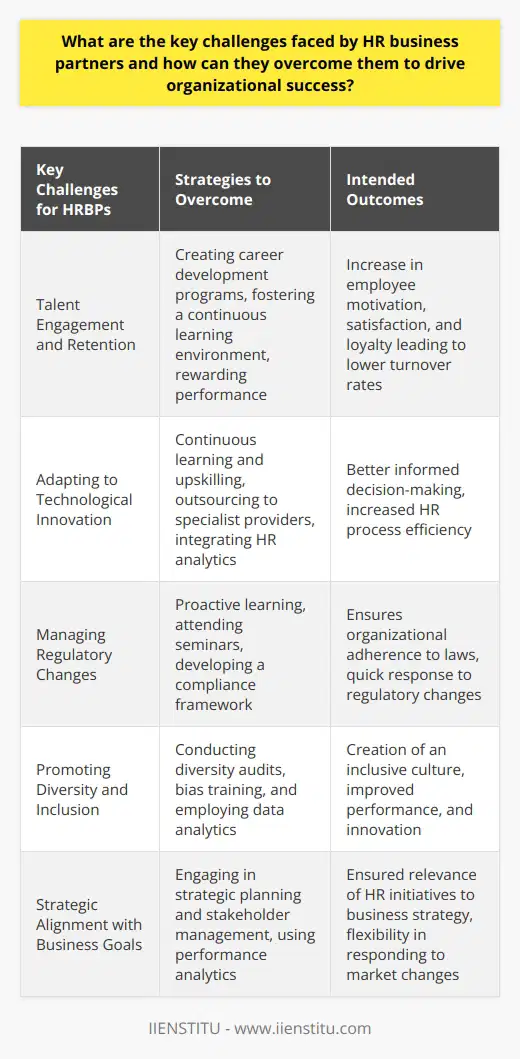
What is the main role of an HR business partner?
Role Examination of an HR Business Partner
The core role of an Human Resources (HR) Business Partner centers on acting as a liaison between HR and other business departments.
Strategic Partnership
They build a strategic partnership, aligning HR strategies with business objectives. They must be familiar with business goals and translate them into HR initiatives.
Resolving Employee Issues
Resolving employee issues comes under their scope of work. They serve as a point of contact for employees and managers for any HR-related queries or concerns, lending their expertise to help resolve any matters.
Improving Workplace Climate
The HR Business Partner operates to enhance the workplace climate. They work towards promoting a positive workplace environment, encouraging work-life balance, and ensuring employee satisfaction.
Driving Organizational Change
HR Business Partners play a vital role in driving organizational change. They are part of creating and implementing change initiatives that align with the organization's overall strategy.
Talent Management
They are also in charge of talent management. HR Business Partners assist in identifying and developing key talents, enabling the organization to meet future business challenges.
Workforce Planning
Workforce planning is another key role. They aid in forecasting the organization’s future staffing needs, ensuring it is well-placed for future success.
Overall, the HR Business Partner’s role is geared towards integrating HR policies and practices into daily operations, driving strategic initiatives, and fostering an environment that leverages human capital. Their role changes as business needs evolve, reflecting the dynamic relationship between HR and business strategies.
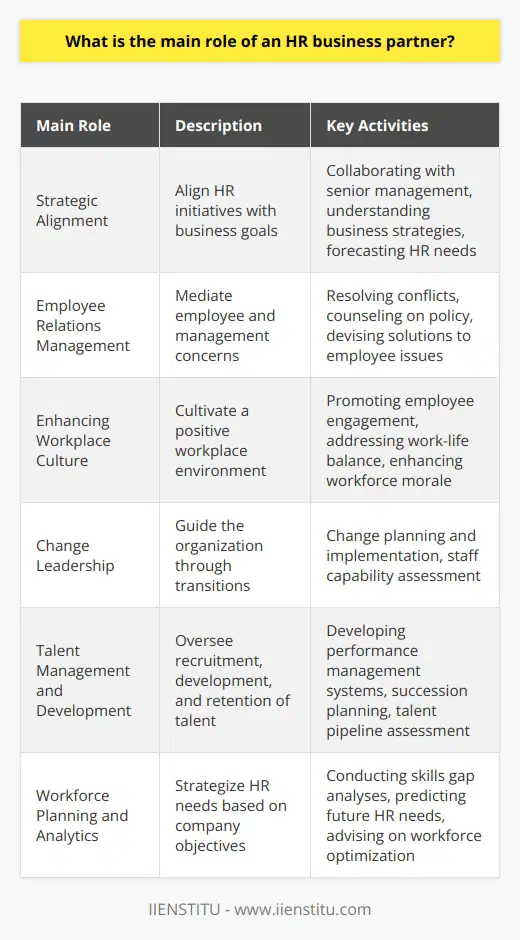
How does the HR business partner role help human resources to become a strategic partner of the organization?
The Integration of HR and Organizational Strategy
The HR business partner role acts as a pivotal element in molding human resources (HR) into a strategic counterpart of an organization. This relationship stimulates enhanced organizational growth and competitiveness. It accomplishes this by syncing HR activities with the organization's strategic goals.
Acting as an Internal Consultant
HR business partners operate as internal consultants. They offer advice to departmental heads and executives on HR issues related to strategic planning. They facilitate strategic decisions regarding workforce planning, talent management, succession planning, and more by providing valuable insights derived from HR data. This aids in improving employee performance, thereby enhancing the overall efficiency of the organization.
Catalysts for Organizational Success
The integration of HR strategy with business goals spurs organizational success. HR business partners identify, develop, and retain talent that aligns with the company's strategic goals. They organize initiatives to meet these targets, thereby fostering employee engagement and productivity.
Ensuring Compliance and Employee Satisfaction
They don't just contribute to maximum attainment of the company's goal, but also ensure compliances and employee satisfaction. This happens through creating positive work environments and encouraging fair practices. They protect the organization's interest by preventing possible legal complications and safeguard the employees by advocating their rights.
Fostering Innovation and Adaptability
HR business partners foster innovation within the organization. They ensure that organizational culture supports creativity and adaptability. Aiding the organization to be competitive in the ever-changing business world.
In conclusion, the HR business partner role is instrumental in transforming the HR department from being a mere administrative function to being a strategic partner of the organization. This is done by aligning human resource strategies with the overall business goals, thereby driving the organization towards greater success.

What are the essential qualities and attributes that an effective HR business partner should possess?
Understanding the Role
An effective HR business partner is a critical cog in the corporate machine. This role necessitates multifaceted individuals possessing several vital qualities and attributes.
Interpersonal Skills
Foremost among these is exceptional interpersonal skills. HR business partners must be proficient in communicating and mediating, both in person and virtually. Their success relies heavily on their ability to interact with employees at all levels of the business.
Business Acumen
Additionally, strong business acumen is imperative. An understanding of the organization's objectives, strategies, and industry is essential. They must interpret and apply this knowledge in a way that maximizes the effectiveness of HR operations.
Strategic Thinking
Furthermore, strategic thinking is crucial. HR business partners need to anticipate potential future challenges and devise solutions. They must think proactively and strategically, playing a key role in driving the business forward.
Integrity and Discretion
Moreover, integrity and discretion are indispensable. Their role often involves handling sensitive issues and private information. HR business partners must demonstrate unwavering integrity and respect for confidentiality at all times.
Leadership Skills
Leadership skills are also a necessary attribute. They often have to guide both the HR team and the broader organization, making firm and fair decisions.
Technical Competency
Lastly, technical competency in HR practices and principles is a necessity. HR business partners should possess a deep knowledge of HR laws, policies, and procedures. They should also be adept at using HR software and data analytics tools.
In conclusion, the effectiveness of a HR business partner hinges on a diverse range of qualities – from interpersonal skills and business acumen to leadership and technical capabilities. As such, organizations must be rigorous in their selection and development of individuals for this pivotal role.
